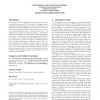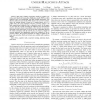240 search results - page 4 / 48 » Malicious Users in Unstructured Networks |
GLOBECOM
2009
IEEE
13 years 5 months ago
2009
IEEE
Collaborative spectrum sensing in cognitive radio networks has been proposed as an efficient way to improve the performance of primary users detection. In collaborative spectrum se...
CCS
2004
ACM
14 years 25 days ago
2004
ACM
This paper studies the problem of resource discovery in unstructured peer-to-peer (P2P) systems. We propose simple policies that make the discovery of resources resilient to coord...
ICASSP
2011
IEEE
12 years 11 months ago
2011
IEEE
Abstract—This paper considers cooperative sensing in cognitive networks under Spectrum Sensing Data Falsification attack (SSDF) in which malicious users can intentionally send f...
SAC
2010
ACM
14 years 2 months ago
2010
ACM
Hosts infected with malicious software, so called malware, are ubiquitous in today’s computer networks. The means whereby malware can infiltrate a network are manifold and rang...
INFOCOM
2007
IEEE
14 years 1 months ago
2007
IEEE
— Previous analytical studies [12], [18] of unstructured P2P resilience have assumed exponential user lifetimes and only considered age-independent neighbor replacement. In this ...


